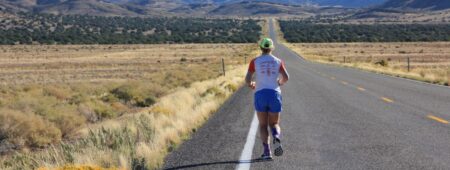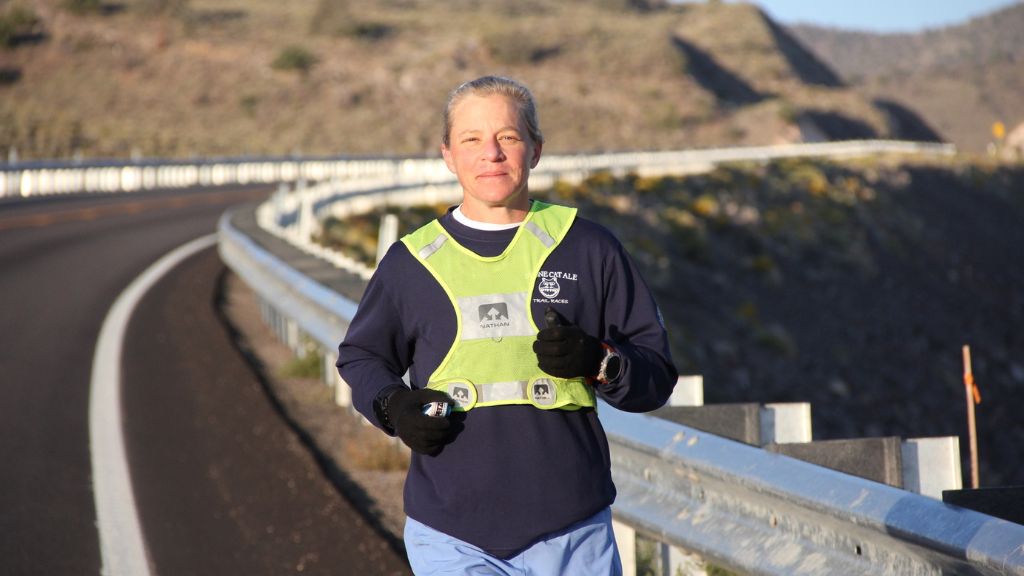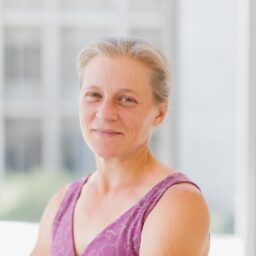
Hertz Fellow Runs a Harvard Lab — and Runs Across the Country
In her day job, Hertz Fellow Jenny Hoffman studies the organization and interactions of electrons in solid state materials. But when she’s not at work, she’s an ultramarathoner, who recently broke the world record for running across the U.S.A.
“You need a good team around you,” says Hoffman. “You need to be around people who support you and treat you well, and that’s where the magic happens.”

Hoffman, a professor of physics at Harvard, is talking about science when she says that; her lab has more than 20 students and fellows who inspire her and keep her motivated to do cutting-edge research on the electronic properties of exotic materials. But Hoffman uses nearly the same line to speak about her recent world-record-setting run across the United States, racing from San Francisco to New York City in 47.5 days. During that cross-country traverse, a dedicated support crew helped plan and carry out the logistics of her runs, from her route and nutrition to her laundry and tracking devices.
“I’m driven to do the hard thing. It’s satisfying to know that I’ve pushed my own limits and done the best I can do,” says Hoffman, again speaking of both her research and her ultrarunning hobby. “I guess the same thing that made me want to be a physicist when there were almost no women in physics also makes me want to break these world records.”
Hoffman grew up in Connecticut; she daydreamed about becoming a professor at Harvard and competing at the Olympics. She had long loved math and physics when she entered Harvard as an undergraduate, and thought she wanted to study high-energy physics — the kind of physics that uses massive particle accelerators to collide electrons, protons, and ions. But by the time Hoffman began her graduate studies at the University of California Berkeley, she didn’t like the idea of having to constantly travel to one of the few accelerators in the world to carry out her research.
“I started to feel like high-energy physics wasn’t compatible with the kind of work-life balance that I hoped for someday,” she says, perhaps foreshadowing how important her running would become to her.
So Hoffman joined a solid-state physics lab at Berkeley — mostly because it was one of the few labs in the department with other female graduate students.
“It was kind of on a whim,” she says. “I didn’t even really know what solid state physics was but I very quickly fell in love with it. It turns out that I really just love research and if I’m around engaging people, then I will be interested in any problem that we’re pursuing together as a team.”
Hoffman’s graduate research involved developing a new scanning tunneling microscope (STM) and analysis techniques to understand how the electrons interact with each other within complex materials such as cuprate (copper-based) superconductors. Understanding how atomic structure gives rise to interesting properties can inform the design of new materials for electronic devices. But Hoffman’s work initially relied on a microscope that a more senior graduate student had already built. When Hoffman won a Hertz Fellowship during her second year at Berkeley, she was able to build her own new microscope.
“If I hadn’t had that Hertz funding, I don’t think I would have had the opportunity to build my own microscope and without that hands-on experience, I don’t think I would have been prepared to launch my own lab from scratch,” she says.
Now, as a professor at Harvard, Hoffman still uses STM and other scanning probe microscopes to visualize what electrons are doing inside solid-state materials. Shortly after she became a faculty member, a new class of superconductors — iron-based rather than copper-based — was discovered, and she pivoted to characterize these materials. Since, she has expanded her focus to study additional quantum materials, including topological insulators, magnets, and others with properties that might be useful for technological applications.
Last year, shortly before she set off to run across the country, Hoffman published new data in Science on how single atom defects within a material known as samarium hexaboride (SmB6) may compromise its unusual ability to insulate in the middle and conduct on the surface. Having imaged the static configurations of electrons using STM, Hoffman’s team is now developing a new scanning probe technique to image the motion of electrons in SmB6.
Recently, Hoffman has also starting using sound waves to mimic the behavior of electrons within materials.
“It turns out that the way acoustic waves travel is very similar to the way electrons travel, just at a different length scale and frequency,” says Hoffman. “So we can do a lot of modeling of quantum electronic materials using acoustics and it’s a thousand times cheaper and faster, making it much more accessible to students.”
Hoffman’s group uses nanofabrication tools – such as those that etch the patterns on computer chips – to create new structures not usually seen in nature, and then study how the acoustic waves interact with those structures. In 2022, they reported the first topological acoustic transistor, which mimicked the properties of a quantum topological insulator using acoustic waves. The findings could not only inform the development of quantum materials and devices, but also be a boon to scientists developing new ultrasound and echolocation technologies.
“If we find some patterns that give rise to interesting acoustic properties, that suggests that the analogous quantum material might have interesting, useful electronic properties,” Hoffman explains.
When she’s not in the lab, or spending time with her family, Hoffman can usually be found running. In the years leading up to conquering the cross-continent record, she won multiple ultrarunning national championships and logged thousands of miles running a year. When she’s on the roads and trails, she says, is the only time her brain takes a break — she doesn’t think about physics at all.
Recently, Hoffman renewed her annual support for the Hertz Foundation and joined the 2023 Summer Workshop in San Diego. The support was in part inspired by one of her running partners — Hertz Fellow Katherine Van Kirk, a current physics graduate student at Harvard. Hearing about Van Kirk’s experiences reminded Hoffman of how vital the foundation was to getting her own career started, she says, and made her want to give back.
“I have benefitted from the Hertz Foundation, both as a student 23 years ago, and as a faculty adviser now,” she says. “So I feel that I should give back."
